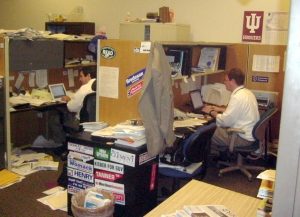Ask yourself how people find out what’s happening in state government. They read about it in the newspaper, or they see stories about it on television, right? So who makes that happen? Reporters do. The people who cover state government are important and overlooked people.
The job of keeping Tennessee’s nine million citizens informed about the goings on at the State Capitol falls squarely on the shoulders of these reporters. You might be surprised to learn how few of them there are. In the spring of 2017, newspapers in Memphis, Nashville and Knoxville shared the work of three reporters, while the Chattanooga newspaper had one.
That’s four people to cover house, senate, Supreme Court, governor and all those departments of state government. In addition to those four people, Associated Press, which writes stories that are used by newspapers, television stations and radio broadcasts, had two people, and Nashville Public Radio had one.
But what about all the other newspapers, and what about all those television and radio reporters? True, they file stories from the State Capitol sometimes. But those reporters come and go. They generally don’t cover things on a day-to-day basis, keeping an eye out for what might be happening. And they certainly don’t cover all the house and senate committees and subcommittees, which last for eight hours a day, two days a week when the legislature is in session.
This is important to remember. Almost everything that you see and read about the legislature is written by this very small group of people. If they missed an important bill, or a committee, or an deal that was made, then you (the citizen) may never hear about it.
Imagine, for instance, the situation that one of these reporters is in on a typical Wednesday during the month of April, when the legislature is in full swing. The house has several committees meeting all day, each of them considering dozens of bills, and that reporter often has no way of knowing which ones will actually be discussed. The senate has several committees meeting all day, each of them considering dozens of different bills, and (again) that reporter has no way of knowing which ones will actually be discussed. The Supreme Court might announce an unexpected decision or two. The governor might make an important announcement. And, meanwhile, any number of groups lobbying the legislature might call a press conference or two.
A reporter could, on such a day, file stories about twenty different things — that is, if they could possibly manage to cover everything. But even if a reporter did file twenty stories, his or her newspaper would only publish two or three of them.
By the way, things didn’t used to be like this. Not long ago each of Tennessee’s four largest cities had TWO daily newspapers, and many of those newspapers felt obligated to each have TWO reporters covering the State Capitol. In fact, when the state built Legislative Plaza in the early 1970s, no less than 32 parking spaces were designated for reporters.
But during the 1980s and 1990s, each of Tennessee’s four largest cities lost one of their two daily newspapers. And in the years since, most of them have reduced their commitments to covering government. As recently as 1997, for instance, there were usually half a dozen reporters covering the Senate Judiciary Committee, which meets on Wednesday afternoon at 3:30. By 2003 the committee often met without a single reporter in the room.


